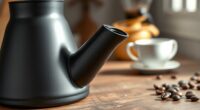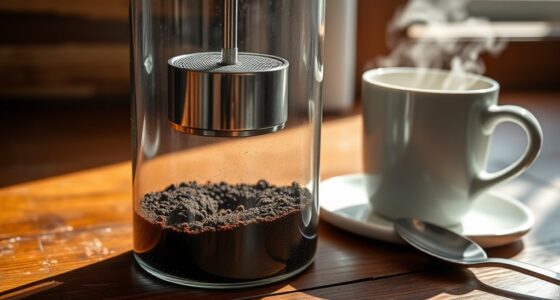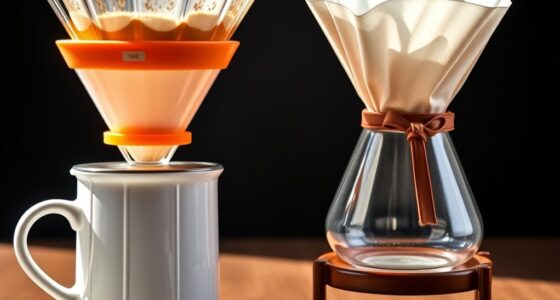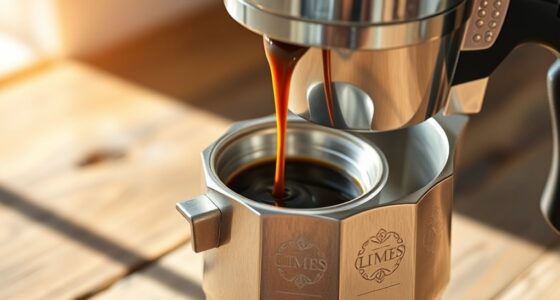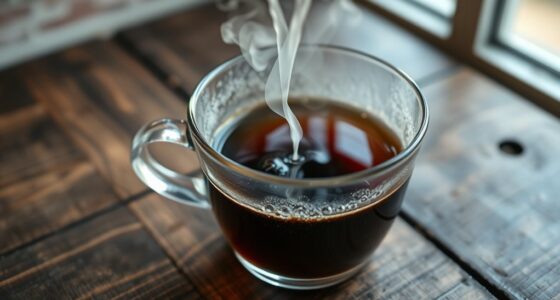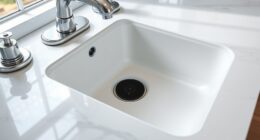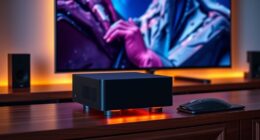To set up for success with your first brew, choose immersion if you want a simple, full-bodied flavor by fully submerging grounds in water, and percolation if you prefer a clean, consistent brew through continuous water flow. Use the right equipment, like filters and precise grind sizes, and control variables like temperature and timing carefully. Keep experimenting and adjusting, and you’ll discover tips to perfect your brewing method as you continue exploring.
Key Takeaways
- Ensure proper grind size: medium-coarse for percolation, medium for immersion, to optimize extraction.
- Use freshly roasted, high-quality beans and filtered water at 195–205°F for consistent flavor.
- Maintain clean equipment and correct assembly to prevent blockages and ensure even brewing.
- Adjust brew time based on method: longer for immersion, shorter for percolation, to avoid over- or under-extraction.
- Follow specific process steps for each method to achieve balanced, flavorful coffee on your first attempt.
Understanding the Basics of Coffee Extraction
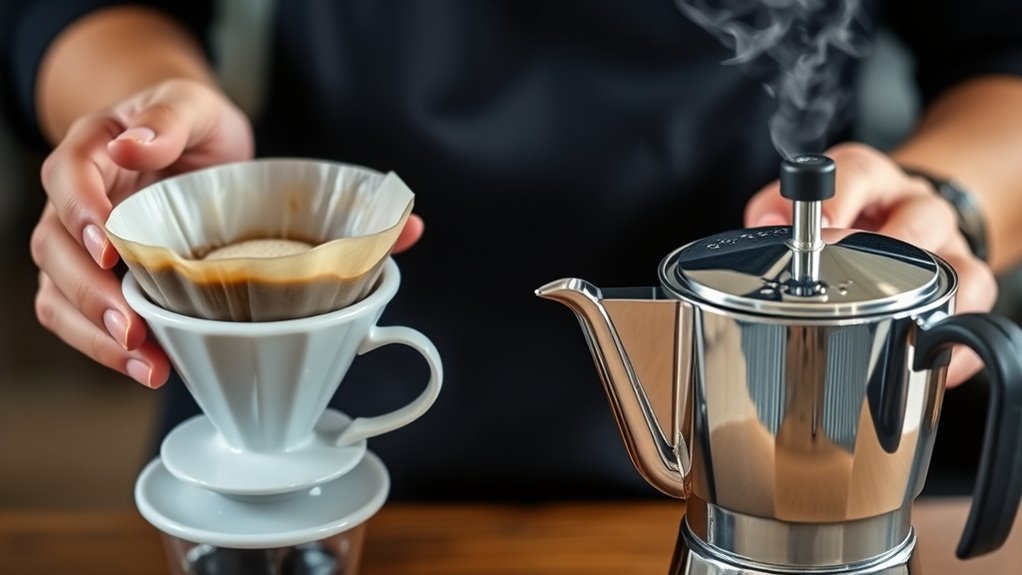
To understand coffee extraction, you need to grasp how hot water interacts with coffee grounds to pull out flavors and compounds. Different coffee bean varieties have unique flavor profiles, which influence how they respond during extraction. For example, Arabica beans tend to produce sweeter, more nuanced flavors, while Robusta beans often yield stronger, more bitter notes. As hot water passes through the grounds, it dissolves soluble compounds like acids, sugars, and oils, shaping the final taste. The balance of extraction depends on factors like grind size, temperature, and brew time. Knowing the characteristics of various beans helps you control extraction to highlight desired flavors and avoid over- or under-extracting, ensuring a better cup every time. Additionally, understanding the essential oils within coffee can help optimize extraction for a more aromatic and flavorful brew.
Essential Equipment for Immersion Brewing

To brew great coffee with immersion, you need a reliable water source, quality brewing tools, and precise temperature regulation. These essentials ensure your extraction is consistent and flavorful. Without them, even the best beans can fall short of their potential. Additionally, maintaining optimal temperature control can significantly influence the effectiveness of your brew.
Quality Water Source
Have you ever considered how much the quality of your water impacts your immersion brewing? Using water with proper filtration can remove impurities that might negatively affect flavor. It’s also vital to pay attention to mineral content, as minerals influence extraction and taste. Hard water with high calcium or magnesium levels can lead to over-extraction, making your coffee bitter, while soft water may produce a flat flavor. Ideally, you want water that’s balanced, with a moderate mineral content suited for brewing. Investing in a good water filtration system ensures cleaner water and consistent results. Understanding how water quality affects extraction can help you fine-tune your brewing process for optimal flavor. Remember, the quality of your water source directly affects your final brew’s clarity, flavor, and overall quality, making it a key element in your immersion setup.
Proper Brewing Tools
Having the right brewing tools is essential for achieving consistent and flavorful immersion coffee. Investing in quality equipment ensures your coffee flavor remains rich and well-balanced with every brew. A good immersion brewer, like a French press or AeroPress, should be durable and easy to clean, supporting ideal extraction. Precise measurement tools, such as a scale, help you maintain the right coffee-to-water ratio, enhancing both flavor and brewing aesthetics. A timer ensures consistent steeping times, preventing over- or under-extraction. Additionally, a gooseneck kettle offers better control over pouring, contributing to a cleaner presentation and more appealing look. Using the proper tools not only maximizes coffee flavor but also creates a satisfying visual experience that elevates your brewing routine. Referencing support hours can help you plan your visits to local coffee shops or equipment stores to get expert advice or service.
Correct Temperature Control
Proper brewing tools set the foundation for great immersion coffee, but controlling the brewing temperature guarantees those flavors develop ideally. Achieving temperature stability is vital; fluctuations can lead to inconsistent extraction and dull flavors. Use a thermometer and a kettle with precise temperature control to maintain the ideal range—usually between 195°F and 205°F. Good heat distribution within your brewing vessel prevents hot spots that can over-extract or under-extract certain areas. Monitor the temperature throughout the brew, adjusting as needed to keep it steady. Consistent heat ensures even extraction, revealing the coffee’s nuanced flavors. Investing in equipment that promotes Mazda Tuning temperature stability and even heat distribution helps you produce a balanced, flavorful cup every time.
Key Tools for Percolation Methods

To succeed with percolation methods, you need reliable filtering devices that keep grounds out of your brew. Having the right brewing equipment guarantees consistent results and smooth operation. Proper filtering devices are essential to prevent irritation and ensure the effectiveness of your eye patch regimen, much like choosing the appropriate tools for a precise brewing process. Let’s explore the essential tools that will help you master this technique efficiently.
Effective Filtering Devices
Effective filtering devices are essential tools in percolation methods because they guarantee that only desired particles pass through, preventing blockages and maintaining smooth flow. When selecting filtering devices, consider their mesh size, durability, and compatibility with your brewing equipment. Proper filters ensure contaminants are removed early, reducing maintenance and improving final quality. Using the right filtering devices in your setup helps you achieve consistent results, whether you’re brewing coffee or other infused liquids. They also protect your percolation system from clogging, saving you time and effort. Remember, high-quality filters are an investment in your process. Keep an eye out for these key features:
- Fine mesh screens
- Reusable filter baskets
- Disposable paper filters
- Stainless steel filters
- Understanding filtration efficiency can help you select the most suitable options for your specific needs.
Brewing Equipment Essentials
Choosing the right brewing equipment makes a significant difference in your percolation process. The tools you select influence coffee flavor and shape your brewing rituals. A well-designed percolator ensures consistent extraction, enhancing aromatic complexity. Think about the essential equipment:
| Equipment | Purpose |
|---|---|
| Percolator | Continuous brewing for bold flavor |
| Filter Basket | Ensures clarity and prevents grounds |
| Heat Source | Maintains ideal temperature |
| Coffee Grinder | Freshly ground beans boost flavor |
| Thermometer | Precise temperature control |
This setup helps you craft a rich, flavorful cup, elevating your percolation experience. Investing in quality equipment simplifies your brewing rituals and guarantees a better coffee flavor with every brew.
Additionally, selecting appropriate brewing techniques can further enhance your results.
Step-by-Step Guide to Setting Up Your Immersion Brew

Setting up your immersion brew is straightforward when you follow a clear process. First, choose quality coffee bean varieties that suit your taste, considering options with unique flavor profiles. Next, measure the right amount of coffee and grind it to a consistent, medium-coarse texture. Fill your vessel with filtered water, maintaining the ideal temperature for extraction. Then, add the coffee grounds, ensuring they’re fully submerged for even brewing. To enhance your experience, incorporate sustainability practices like using reusable filters and eco-friendly beans. Additionally, selecting high-quality components such as durable filters and precise temperature controls can improve your brewing results.
Here’s a quick checklist:
- Select high-quality, sustainable coffee beans
- Grind to medium-coarse consistency
- Use filtered water at the right temperature
- Fully submerge grounds for even extraction
Setting Up for Successful Percolation Brewing
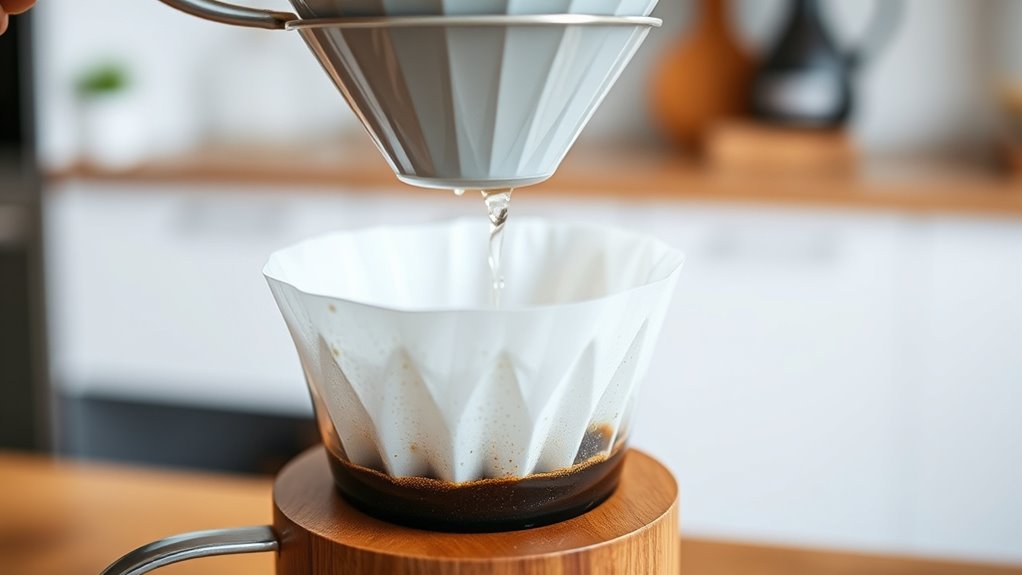
To guarantee successful percolation brewing, start by assembling your equipment properly. Fresh coffee beans are essential; use recently roasted beans for ideal flavor. Pay attention to water mineral content—aim for balanced minerals to enhance extraction without over-softening or hardening the brew. Ensure your percolator is clean and in good condition to prevent off-flavors. Use a consistent coffee-to-water ratio and fill the chamber appropriately. Here’s a quick checklist:
| Equipment | Water Quality | Coffee Freshness |
|---|---|---|
| Clean percolator | Filtered or mineral-balanced water | Recently roasted beans |
Proper setup ensures even water flow, consistent extraction, and a rich, flavorful cup. Focusing on environmental considerations like regular cleaning and maintenance can also extend the lifespan of your equipment and support sustainable brewing practices.
Choosing the Right Coffee Grind and Dosage
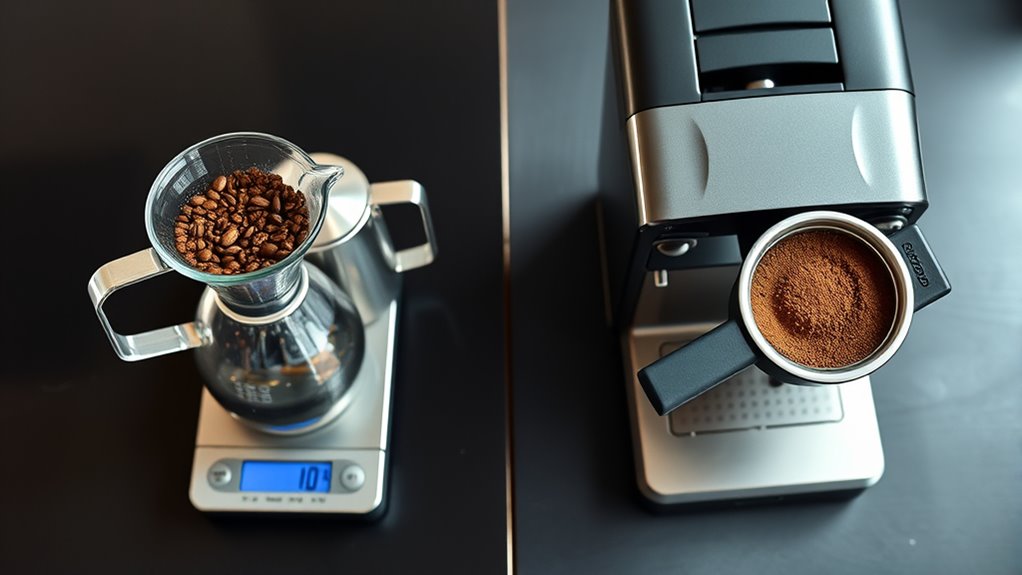
Selecting the right coffee grind size and dosage is essential for extracting the best flavors from your brew. The grind consistency impacts extraction, so aim for uniformity to ensure even water flow. When choosing your coffee bean selection, consider roast level and origin, as these influence flavor. The grind size should match your brewing method: a coarser grind for percolation and a medium for immersion. Proper dosage balances strength and clarity; too much coffee overpowers the brew, while too little results in weak flavor. Using the correct brewing method is crucial for achieving optimal results.
Timing and Temperature Considerations
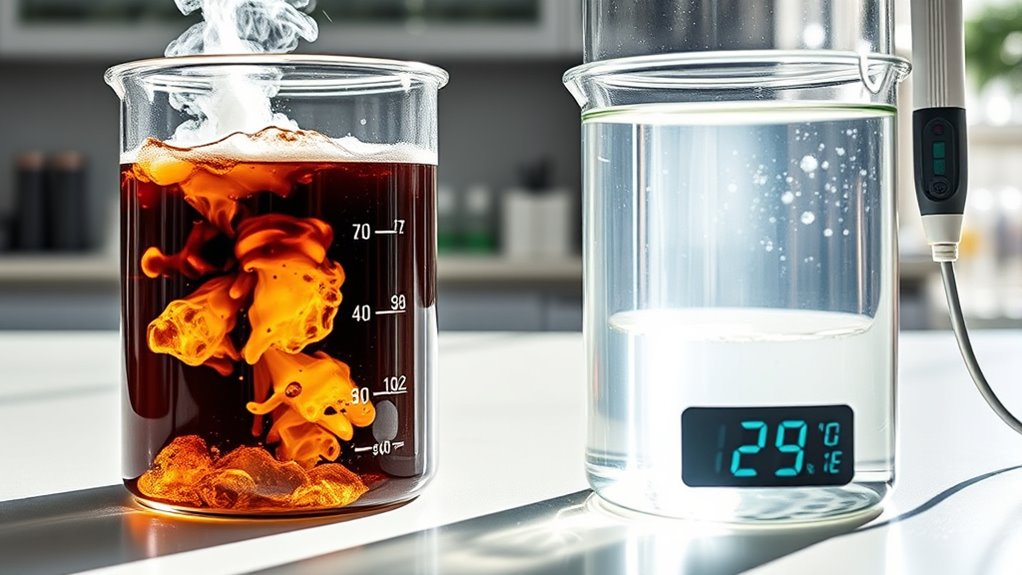
Proper timing and temperature control are key to unsealing the full flavor potential of your coffee. Water temperature directly impacts extraction; ideally, keep it between 195°F and 205°F for maximum flavor. Too hot, and you risk over-extraction, making your coffee bitter; too cool, and you’ll under-extract, resulting in a weak taste. Brew timing also matters—too long, and you might extract undesirable compounds; too short, and the flavors won’t fully develop. Pay close attention to the duration of your brewing process, whether you’re using immersion or percolation methods. Consistent water temperature and precise brew timing help ensure your coffee is balanced, flavorful, and satisfying. Adjusting these variables allows you to fine-tune your setup for the perfect cup every time. Temperature control is essential for achieving optimal extraction and flavor clarity.
Troubleshooting Common Setup Issues
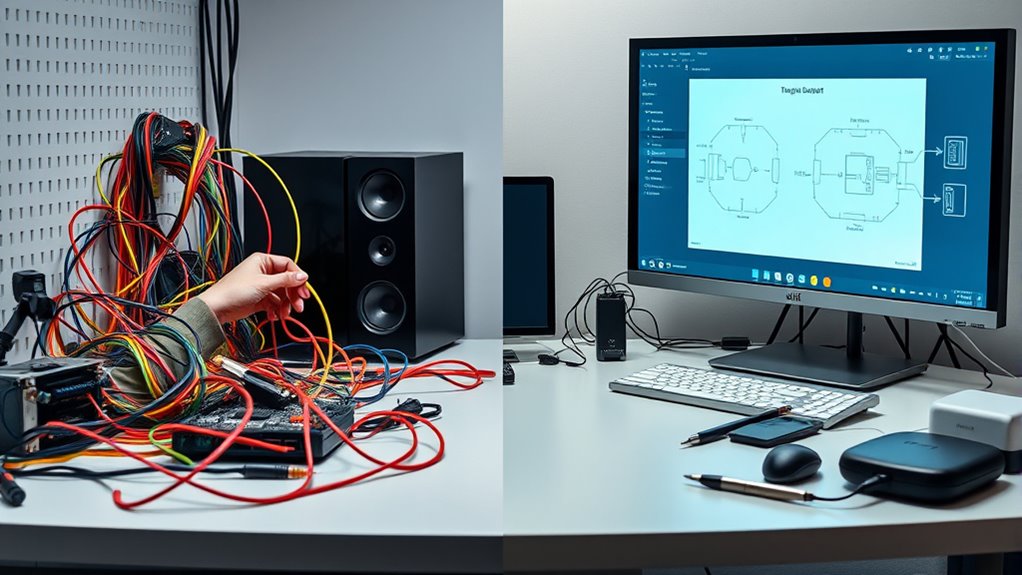
When your coffee setup isn’t producing the desired results, pinpointing common issues can save you time and frustration. Poor flavor or inconsistent brews often stem from overlooked problems. Check your equipment maintenance first—dirty filters or clogged parts can hinder extraction. Make certain your storage solutions keep beans fresh; stale beans affect taste. Misaligned equipment can also cause uneven brewing, so verify all parts are properly assembled. Additionally, improper grind size or inconsistent tamping can impact extraction quality. Regularly cleaning and inspecting your setup prevents buildup and maintains performance. Remember, proper storage solutions and routine equipment maintenance are vital for a reliable setup. Addressing these issues promptly helps you troubleshoot effectively, leading to better brews and an improved coffee experience.
- Dirty or clogged equipment
- Improper storage of beans
- Misaligned or loose parts
- Inconsistent grind size
Tips for Refining Your Brew Technique
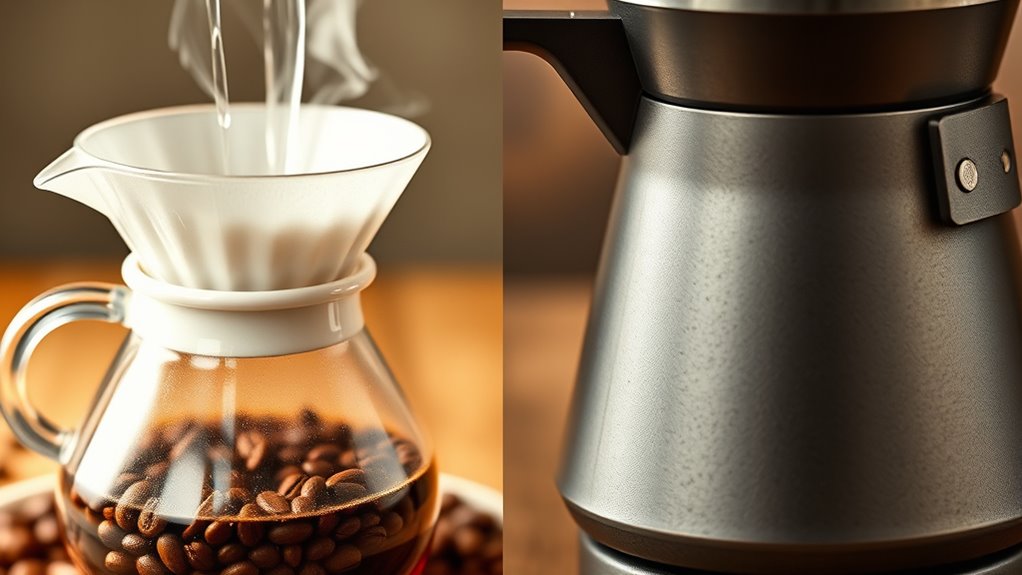
Refining your brew technique can considerably improve the flavor and consistency of your coffee. Focus on adjusting variables like grind size, water temperature, and brew time to enhance both brew aesthetics and flavor profiling. Small tweaks can make a big difference in achieving a well-balanced cup. Visualize your process with this simple table:
| Step | Focus Area |
|---|---|
| Grind size | Consistency & extraction |
| Water temp | Brightness & clarity |
| Brew time | Strength & body |
| Pour technique | Even extraction |
| Filtering method | Cleanliness & clarity |
Being mindful of brew time and other variables can help you fine-tune your brewing method for optimal taste.
Frequently Asked Questions
How Do I Clean and Maintain My Brewing Equipment?
You should establish regular cleaning routines to keep your brewing equipment in top shape. Rinse parts with warm water after each use and use a mild cleaner for thorough cleaning weekly. Descale your equipment to prevent mineral buildup, which can shorten its lifespan. Proper maintenance guarantees consistent brewing quality and extends the life of your gear, saving you money and ensuring every brew tastes great.
What Are Common Mistakes to Avoid During Setup?
To avoid mistakes during setup, double-check your brew timing and make sure equipment calibration is accurate. Don’t rush the calibration process, as improper settings can affect flavor. Avoid skipping steps like cleaning parts beforehand, which can cause contamination. Also, don’t ignore manufacturer instructions, and always verify measurements before brewing. Properly calibrated equipment and precise timing set you up for success, preventing common issues and ensuring consistent, high-quality brews.
Can I Customize Brewing Times for Different Flavors?
Yes, you can customize brewing times to enhance flavor profiles and achieve better brewing flexibility. Adjust the time based on the type of coffee and desired strength—shorter for brighter, delicate flavors, longer for richer, bolder profiles. Experiment with different times to find what works best for each flavor, and keep notes to refine your process. This way, you gain more control over your brew’s taste and overall quality.
How Does Altitude Affect Brewing Parameters?
Altitude impacts your brewing parameters by requiring adjustments in altitude adjustment and brewing pressure. At higher elevations, lower atmospheric pressure means you should increase brewing pressure slightly to extract flavors properly. You might also need to alter brewing times or grind size to compensate for thinner air. By tweaking these settings, you guarantee your coffee’s flavor remains consistent, regardless of altitude, delivering ideal taste every time you brew.
What Are Cost-Effective Options for Beginner Equipment?
For beginner equipment, start with a good quality French press or pour-over cone, as they’re affordable and simple to use. Check the cost comparison of grinders and kettles to find budget-friendly options that still guarantee good coffee quality. Follow beginner tips like using fresh beans and proper grind size. Investing in a basic scale can improve consistency without breaking the bank, making your brewing journey both cost-effective and enjoyable.
Conclusion
Mastering your first brew is like planting a seed—patience and attention nurture perfection. Whether you choose immersion or percolation, the key lies in understanding each step and trusting your taste. Remember, every cup is a story waiting to unfold—your journey is the canvas, and your technique the brush. With practice, your brewing skills will blossom, turning each sip into a masterpiece that reflects your passion and precision.

